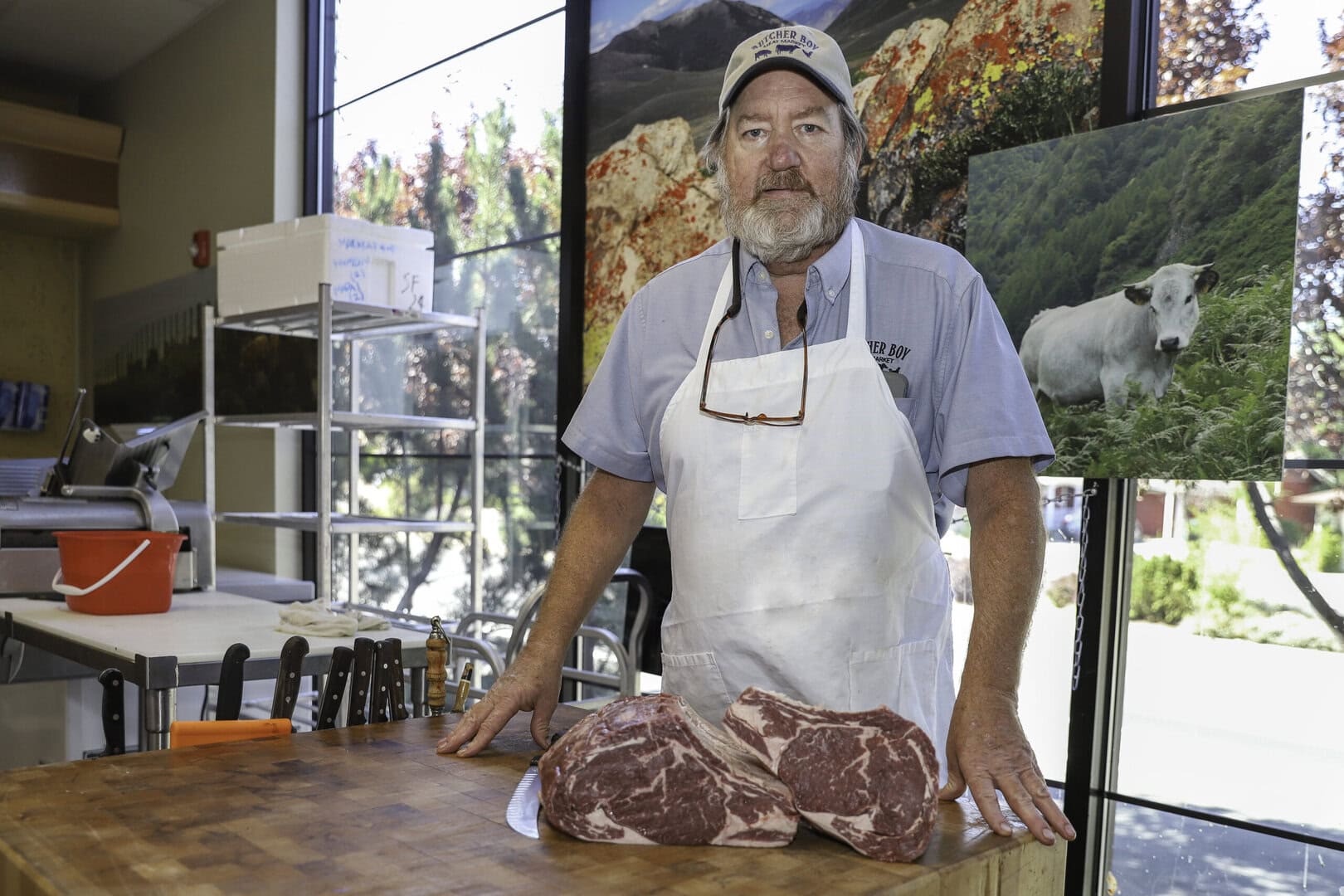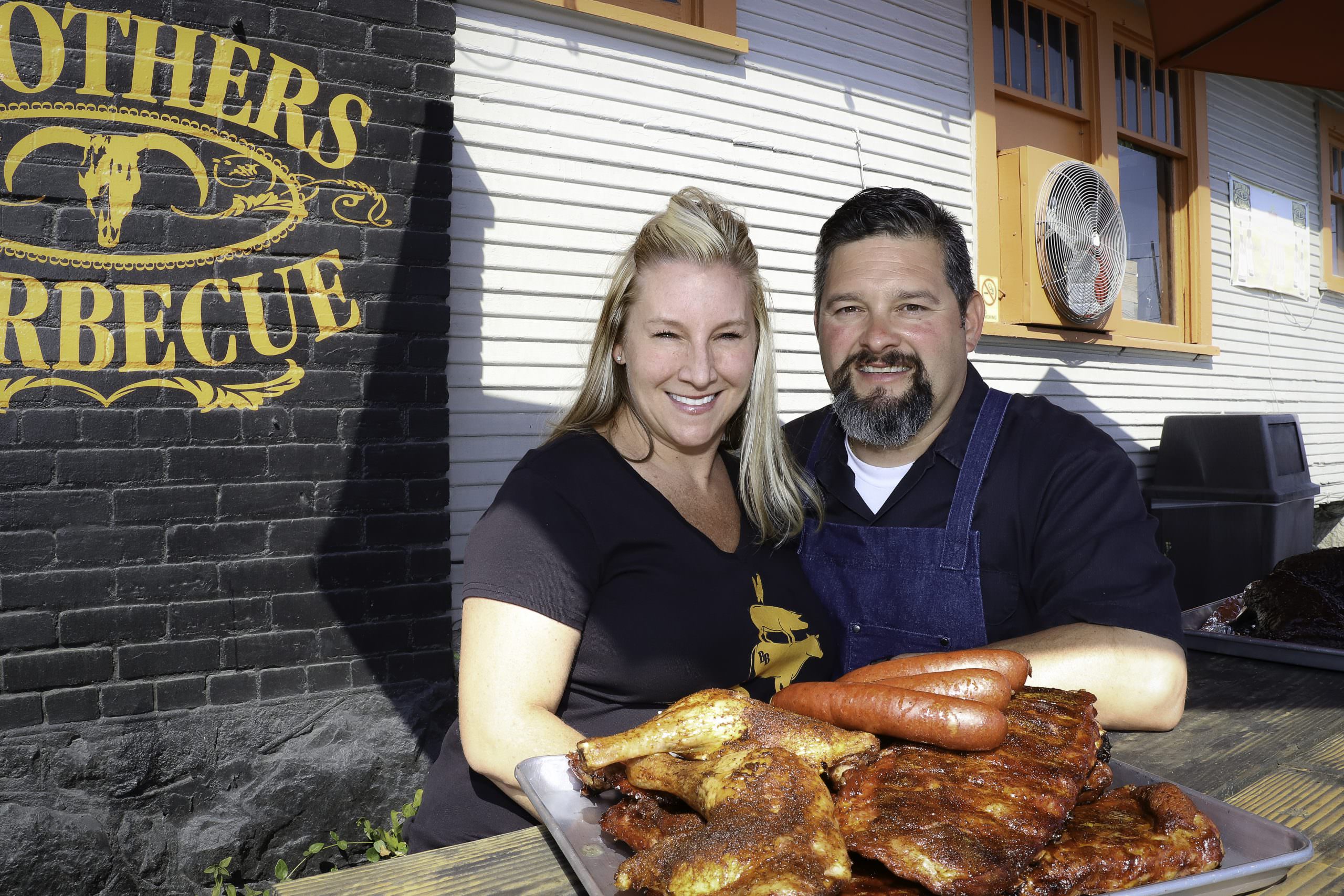Four Northern Nevada families share how they became meat masters.
Nevada’s vast expanses of land have been attracting ranchers for centuries. In 2014, the Nevada Department of Agriculture reported that livestock production represented the largest segment of agriculture in Nevada, with a production value of $420 million in 2012.
But who then takes the reins with the ranchers’ final product? Expert local meat artists, it turns out. Four Northern Nevada families, in particular, have spent generations refining their meat mastery. As such, these professionals help elevate the Reno-Tahoe dining experience.
Barbecue Dreams
It was a dream realized for Ed Ferencik Sr. when Butcher’s Kitchen Char-B-Que opened in South Reno in December 2015. A fast-casual dining concept, it combines his decades of working with meat with his son Eddie’s academic training in culinary arts and beverage management. Trips to the slaughterhouses and smaller farms of upstate New York familiarized the elder Ferencik with the butchering process and instilled in him a lifelong passion for it.
“Butchers were artists … you’d go into a store and see all the beautiful cuts; it was a thing of art,” Ferencik recalls.
After high school, he visited a cousin in the Bay Area and wound up joining the local butcher’s union, making about $9 per hour versus $3 back home. He also gleaned curing and smoking techniques from new friends, becoming further enamored with the industry. After 18 years overseeing the establishment of many warehouse stores’ meat and produce departments, the father of three boys needed a break from corporate culture and moved to Reno to sell office equipment in 2002. But a blood clot in 2004 made him reconsider his priorities and decide to pursue his dreams, which included developing a meat tenderizer he’d conceptualized in his youth and starting a family-run restaurant.
“Reno’s a red-meat-and-potatoes town, but I wondered, ‘Where the hell are the sausage sandwiches?’” Ferencik says.
In late 2015, the Ferencik family opened Butcher’s Kitchen. Ed Sr. makes sausages by hand and presides over grandiose smokers and a grill/rotisserie he modified to cook Santa Maria-style barbecue. Ed Jr. runs the kitchen and front of house; his younger brother, Bob, works the line; and Tom, the youngest brother, helps out, too. The Ferenciks have big plans to franchise their current concept, create a roadhouse-style chophouse, and build a digital resource for others interested in working with meat — all while serving their own meat-filled culinary marvels to customers daily.
Butcher’s Kitchen Char-B-Que
7689 S. Virginia St., Ste. N, Reno • 775-499-5855 • Bkcharbque.com
Creative Curing
One product was missing from the array of offerings that inspired the Rathmann family’s purchase of BJ’s Nevada Barbecue Co. in 1991. Veterans of the restaurant industry, Roberta and Peter Rathmann; their son, Jay; and their daughter, Kelly, were surrounded by cured meats when living in Warsaw N.Y., yet they struggled to find good corned beef and pastrami out west. It was all too salty. They wanted to make their own.
“When you’re in control of the process, you’re in control of the product,” Jay says. “The only place you’re going to get corned beef like mine is here. No one else makes it the way I do; that’s the point.”
Jay was the first to apply and be approved for a curing permit. It was a long road getting permission from the Nevada Division of Public and Behavioral Health, where employees were unfamiliar with the curing process. After receiving a cease-and-desist notice, taking numerous required classes from the Washoe County Health District, and sending products and recipes to the U.S. Food and Drug Administration for certification, Jay was successful.
But beyond revealing it’s a submersion brine, Jay will never share his curing secrets.
“It’s not the cures we use, it’s how our curing process is performed,” he confides.
BJ’s Nevada Barbecue Co.
80 E. Victorian Ave., Sparks • 775-355-1010 • Bjsbbq.com
Butchering in the Bloodline

Like a royal lineage, Ken Jolly’s family butchering history can be traced back four generations. Grandfather George opened a Reno meat market in 1932, and Uncle Dallas opened the original Butcher Boy in Sparks in 1974, where Jolly learned the family trade right out of high school. There he fostered a fervor for meat that he packs like a knife roll into his shop daily — one he also passed along to his son, Clint.
Today, Butcher Boy Meat Market in Reno, which the elder Jolly now owns, is quite evolved from the shop of his youth. Products are merchandised and displayed differently. Flank, skirt, and flat-iron steaks are frequently requested in this post-sirloin world. Whereas the shop used to carry large slabs of meat, today ready-to-cook items are desired. It’s the customer interaction, cutting meat, and watching trends change that keep him interested and immersed in the industry, along with the chance to pass down skills to his son.
Young Clint started working in his father’s shop in 1992 and discovered a love of cooking in the Butcher Boy deli. Today, he is exploring the butchering and cooking habits in many developing countries around the world. He says the average meats to which Americans have access are far better than anything he’s seen abroad.
“My passion is stronger than it ever was before,” Clint says. “Most Americans are spoiled. In some countries, meat is a luxury.”
One day, Ken will retire, and he hopes to pass the torch to his son.
“I learn something new every day,” Ken Jolly says. “I wouldn’t have done anything differently.”
Butcher Boy Meat Market
530 W. Plumb Lane, Reno • 775-825-6328 • Butcherboyreno.com
Born to Barbecue

A Texas-born, barbecue-loving father instilled an adoration for meat into Joe Orduna Jr. Retired from the gaming industry, Joe Sr. bought a mobile barbecue shack in Las Vegas in 1993, where he pursued his true passion for barbecuing brisket and sausages at events and private functions. His son learned the cooking craft while helping his dad. After some local acclaim, including from his son, who described him as a “one-man show,” Joe Sr. opened a second barbecue shack and handed the keys to his son.
The young Orduna then realized the business’ potential, observing how other places operated, reading cookbooks, and adding pulled pork and ribs to his father’s original menu. Eventually, a family and career in the mortgage industry turned Orduna’s attentions away from the grill — though the flame never extinguished.
In 2006, Orduna took his barbecue on the road in his free time with the purchase of a food truck, following a path similar to his father’s, even using his dry rub recipe. In 2012, he left his job to pursue the ’cue full time, with wife Meagan’s endorsement. In 2014, the couple opened a restaurant on Wells Avenue using a low-and-slow cooking process and high-quality meats that Orduna says they never skimp on. Thrillist, a national media outlet, soon deemed it “the best damn family-owned barbecue in Nevada, by far.”
Cooking fresh daily and lightly saucing items just to complement the meat earned the business this honor, Orduna says, claiming that less is more in his restaurant. His customers serve as daily inspiration.
“It’s really the customer who makes it fun,” he says. “If you can have your group of customers just love you, that’s the best.”
Brothers Barbecue
463 Roberts St., Reno (Moving to Midtown soon!) • 775-384-3547 • Bbqreno.com
A native-Nevadan lover of meat, Natasha Bourlin has newfound appreciation for the many art forms surrounding her beloved steaks.
Basic Steak Recipe
(courtesy of Chef Clint Jolly, chef, Butcher Boy Meat Market in Reno. Serves 1 to 2)
A good steak, at least 1 inch thick
Sea salt (coarse flakes are best)
Let steak sit at room temperature on the counter for 30 to 40 minutes before cooking. Heat oven to 250 degrees F. Cook steak in oven, unseasoned, until it reaches internal temperature of 115 to 120 degrees F.
Heat cast-iron skillet over high heat until smoking. Season steak liberally with salt. Add steak to pan, then sear each side for 60 seconds. Remove from heat, and let rest 5 to 8 minutes before slicing.
BBQ Pit Beef
(courtesy of Butcher’s Kitchen Char-B-Que in Reno. Serves 2 to 4)
Use select beef chuck or beef cross-rib shoulder roast, cut into large chunks (5-by-5 inches or bigger), marinated for 2 or more hours (see recipe for Butcher’s Kitchen Basic Roast & Rib Marinade). Place meat in barbecue smoker, or use indirect cooking method on a charcoal kettle grill.
Smoke meat 2 to 4 hours at 180 to 220 degrees F, using oak and hickory wood chips. Let meat rest and cool before thinly slicing.
Place sliced meat in large pot or slow cooker with meat juices, then cover with fresh marinade. Simmer meat on low heat about 1 hour. Serve meat on crusty bun or bread of your choosing (Dutch crunch rolls work well). Top meat with cool, creamy coleslaw, or preferred toppings.
Butcher’s Kitchen Basic Roast & Rib Marinade
(courtesy of Butcher’s Kitchen Char-B-Que in Reno. Makes 2 cups)
This marinade is best for beef or pork.
1 cup red wine vinegar (use apple cider vinegar for pork)
½ cup ketchup
¼ cup canola or light olive oil
¼ cup soy sauce
¼ cup Worcestershire sauce
½ teaspoon salt
1 teaspoon chopped garlic or garlic powder (fresh garlic preferred)
½ teaspoon dry mustard
¼ teaspoon pepper
Combine all ingredients, whisking in canola oil at the end until smooth. Pour marinade into resealable plastic storage bag. Place meat in bag with marinade, seal bag, then rotate until meat is completely covered. Marinate meat for minimum of 1 hour, or longer if more pronounced flavor is desired. Vinegar will continue to break down meat fibers and further tenderize meat through longer marinating periods. Multiply all ingredients for more volume, except salt. Salt, to taste.
Roast or grill meat to your desired doneness.


